Bike Perfect Verdict
Definitely a niche bike, but if you want a compact, lively Ti frame with total transmission versatility (including gearbox options) the Olsen is a sweet ride at a great price
Pros
- +
Excellent price for an esoteric titanium frame
- +
Masses of tire space
- +
Very neat “any transmission” dropouts
- +
Tight and agile ride
- +
Balanced front end “trail“ handling
- +
Universal T-47 bottom bracket
- +
Neat detailing
- +
Cargo fork mounts
Cons
- -
Stiff feel for titanium
- -
Very short reach
- -
Fit relies on long-stroke dropper posts
- -
No rack mounts
- -
Mixed cable routing
- -
Contact points don’t help comfort
Why trust BikePerfect
Steve Olsen has been designing bikes for other brands for a while but now he’s used that experience – and some unexpected extra time during lockdown – to launch his own range of eclectic MTB and adventure options. The Olsen Mokihinui is an unapologetically different titanium adventure MTB dialed into Steve’s own riding preferences and while it’ll seem odd to some, it might be ideal – and excellent value – for others. So has it got what it takes to join the ranks of the best mountain bikes out there? Read on…

Design and geometry
Steve has his bikes made in Asia from aerospace-grade 3AL / 2.5V titanium to keep costs extremely competitive but it’s obvious from the features and geometry that they’re not just picked out of a catalog.
The Mokihinui has a ring-reinforced 44mm head tube to take a tapered fork and you get a riveted metal head badge too. The head tube cable stop is orphaned on this singlespeed build but it’s placed for zero cable rub if you do add gears. The rear brake line is external too, but there are neat in and out ports for a semi-internal dropper post line. There are also bottle cages above and below the down tube.
While most affordable titanium frames use simple round tubes the Olsen gets an ovalized center-section top tube and down tube that starts ovalized and then curves into the bottom bracket area. It’s an extra-wide 92mm bottom bracket designed to work with a T-47 universal bottom bracket to give maximum stiffness and tire clearance. That’s increased further with an internally and externally machined drive-side chainstay plate and an “S-bent” offside tube that give space for 27.5in x 3.0in or up to 29in x 2.8in tires even with a tubular cross brace. The seatstays are similarly wide stance, welding in alongside rather than behind the super-short seat tube and then looping out wide around the tire with a stout CNC brace for reinforcement.
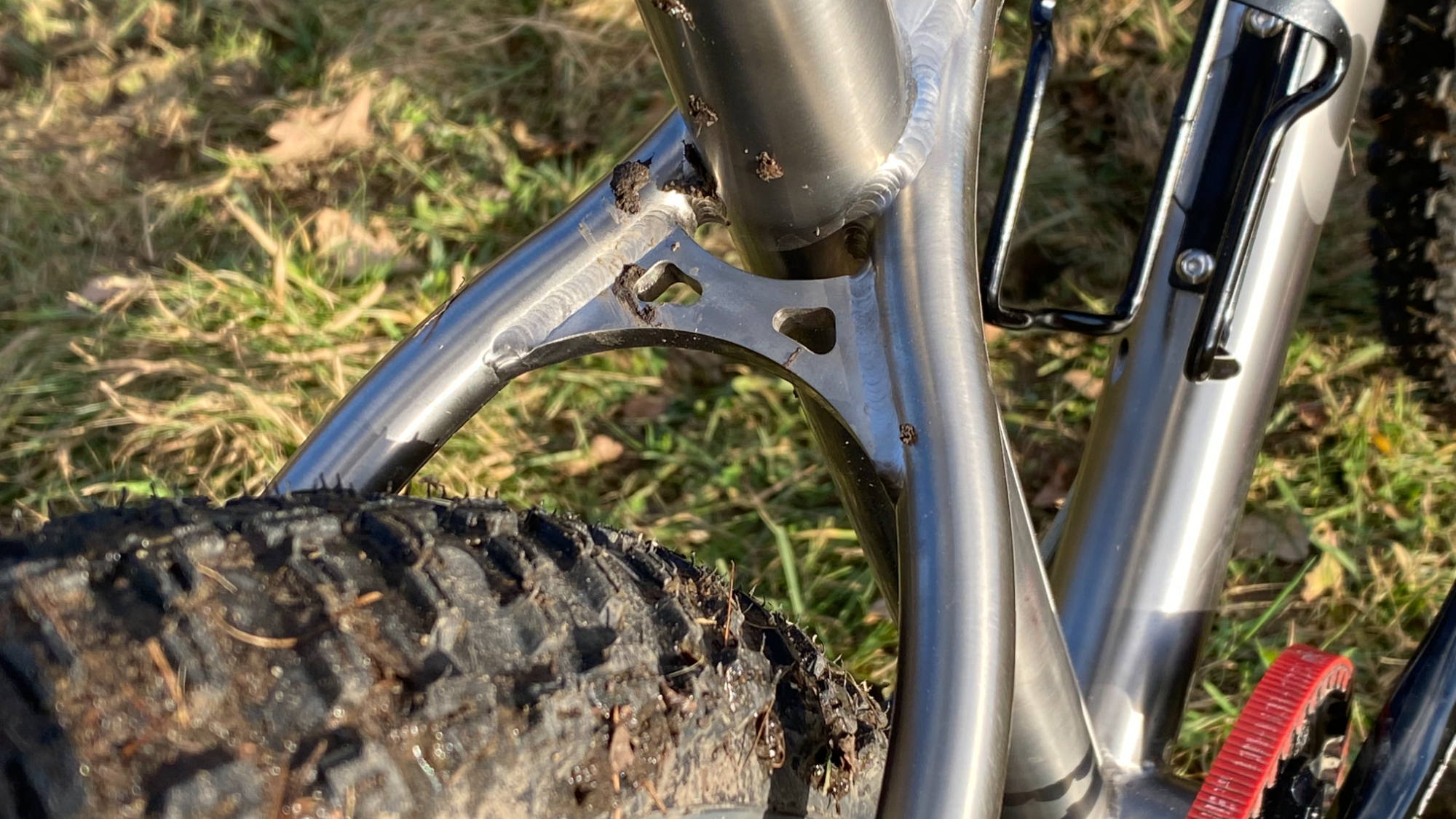
The subtly tapered stays end at Steve’s signature Rock’n’Rollout dropouts. These are long, vertical, round-ended titanium rectangles that are split halfway up on the drive side. CNC-machined alloy dropout sections (with a sliding arc and screw adjusters to tension them) are then bolted into them. This means the rear hanger can be replaced if it’s damaged when you’re running gears, but it also adjusts the wheelbase for belt/chain tensioning. The fact the drive side is split means you can create a gap to slide a pre-joined belt drive into position too. The tensioning screws mounted into the dropouts just push against the back of the Ti frame rather than anchoring into a receiver of any sort so they can work loose and droop down. There are no rack or mudguard mounts on the standard frame either. The rear spacing is also 142mm rather than 148mm Boost which is outdated in terms of most modern wheel fitment but that’s so it matches with common hub gear options. There’s even a Pinion gearbox option if you ask nicely.
The geometry is even more radical than the features as Steve uses the same very short 400mm seat tube and on small, medium and large frames and it’s a traditional 73-degree angle too. The 67-degree head tube is a degree slacker than listed though and at 100mm high it keeps hands low even with a riser bar. And while Steve describes the geometry as long even the large has a decidedly short 450mm reach. Chainstays are relatively long at 435-450mm to accommodate larger tires though so that shifts the dynamic balance back onto its heels.

Components and build
Steve offers frame (currently $1,657 / £999) or complete bike builds and again they’re an eclectic mix. The standard-fit is a MTN HELL full carbon rigid fork with a Boost 110mm x 15mm bolt through dropouts and triple bolt mounts on the rear face of its tapered triangular legs. At 500mm long it’s the same height as a sagged 120mm suspension fork, though, so you can go sprung if you want to. Our bike came with a Carbon Drive belt too, but you can go chained singlespeed or geared if you want.
The rest of the build normally mixes Hope components and own-brand kit from Olsen but we had a Middleburn crank on our sample. Wheel styles and sizes are negotiable too and we used the bike with both a monster Maxxis 27.5in x 3.8in front tire and the Vittoria 27.5in x 2.6in rear tire pictured using the unbranded 50mm wide carbon rims. While contact points are always personal preference the minimally padded Selle Italia saddle and Bike Ribbon grips with prominent metal collars at either end do the comfort levels of the complete bike no favors.
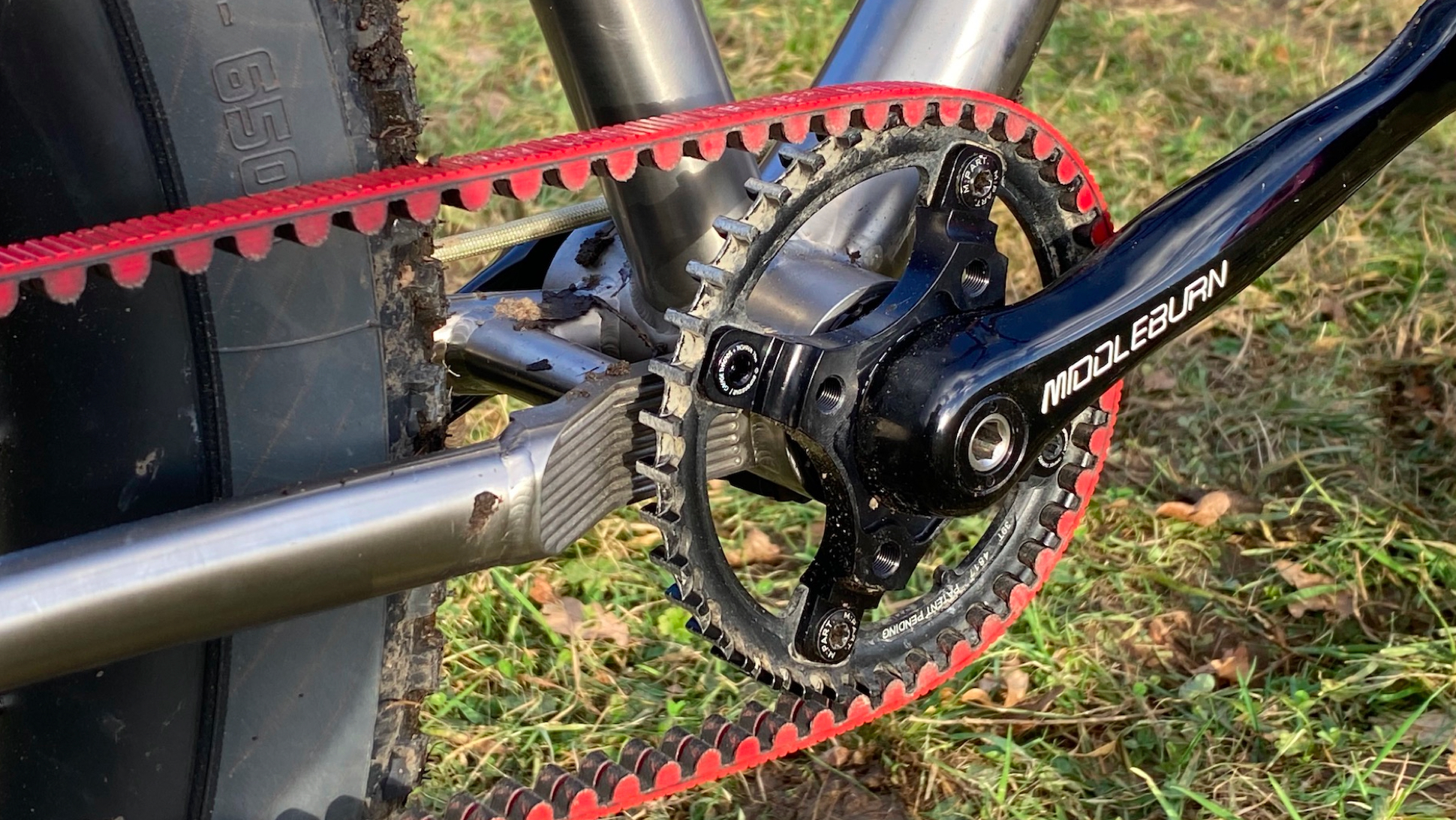
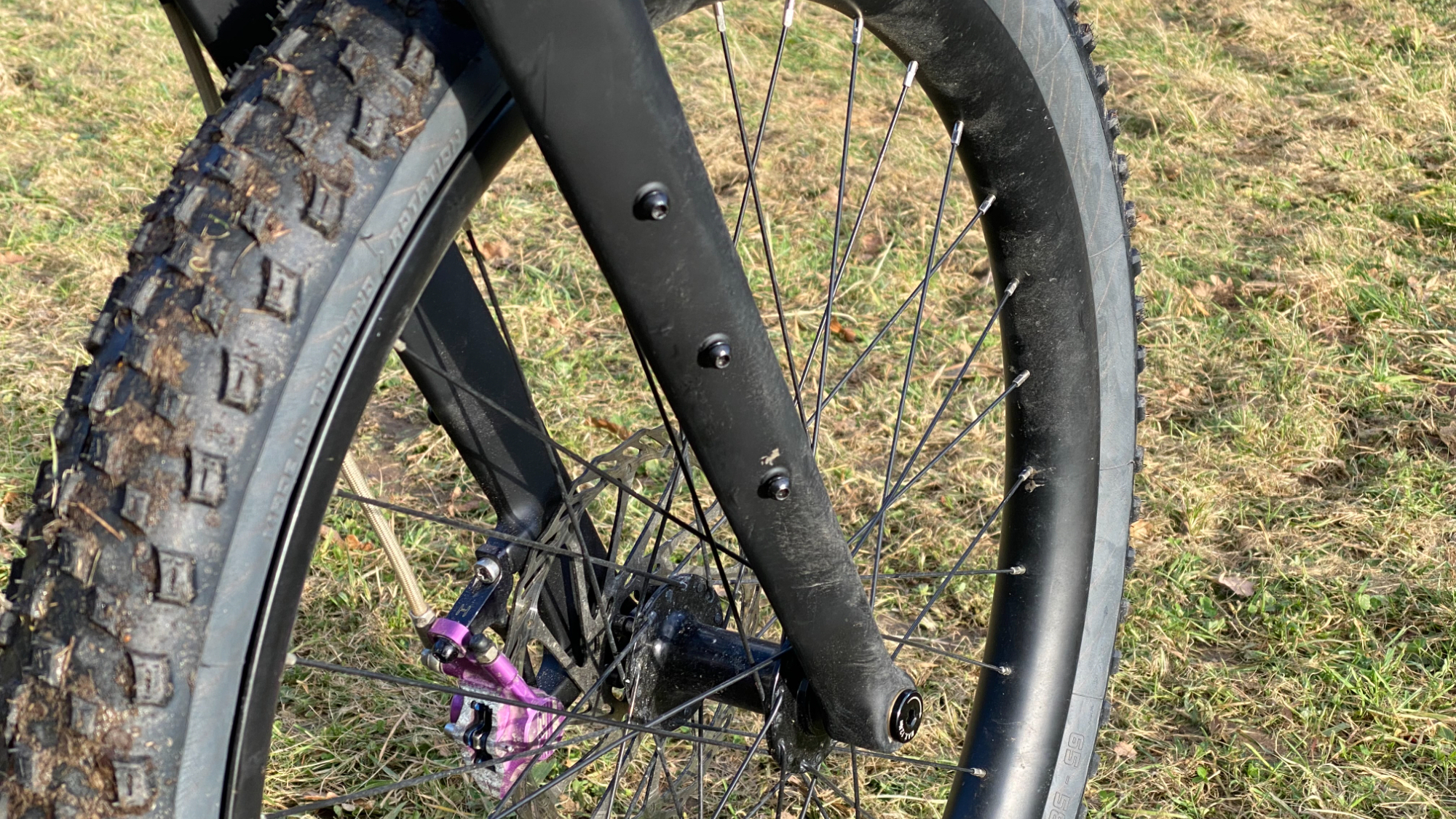
Ride, handling and performance
As you’ll have gathered from the geometry and build, the Mokihinui is a long way from a “normal” trail hardtail when compared to the best hardtail mountain bikes. But that’s a very crowded market even if you’re looking for a titanium bike and Steve’s approach has definite advantages. Not least the distinctive, stripped-down looks lit up my social media with appreciative comments, way more than most conventional bikes. At 10.5kg with the 2.6 XC tires fitted, the 1,500g claimed weight frame also builds into a reasonably light complete bike, although not perhaps the featherweight you’d expect for a rigid Ti singlespeed. Whether you go for frame or complete bike the pricing is excellent for such an eclectic mix and quality detailing that you could reasonably expect to pay a premium for.
The compact, super-low top tube – almost BMX – frame proportions build a very tight and taut ride feel too. While it unsurprisingly has a slightly less direct and clean feel than a chain, the belt drive spins the big tires and rims up to speed easily. It also brings potential zero-lube, reduced-maintenance advantages too, although the experience of our test team suggests belt snapping can have impossible-to-trail-repair and expensive/awkward-to-replace downsides. Given that you can run whatever transmission you want on the Olsen, though, it’s not a make-or-break issue, and the broad bottom bracket width means a powerful propulsive feel.
Again, that would definitely be enhanced by the 30mm axle Hope cranks it should have rather than the skinny Middleburns supplied, but it’s nice to see the UK firm are still making kit. Even with large tires on fat rims, the front-end feel is direct and precise and the long offset fork and short 40mm stem balance for an agile but not too twitchy feel. The relaxed seat angle is less of an issue on a singlespeed where you’ll stand up for steeper climbs although the supplied ratio is already low to help you spin rather than stomp. The compact length also makes the Olsen very keen to sneak around switchback corners and slow-speed wiggles on tight, tree-lined singletrack. It will feel familiar to pilots who haven’t updated their bike in the last few years too.
They will likely have a shock with that Aphex Twin “techno“ steering feel, however.
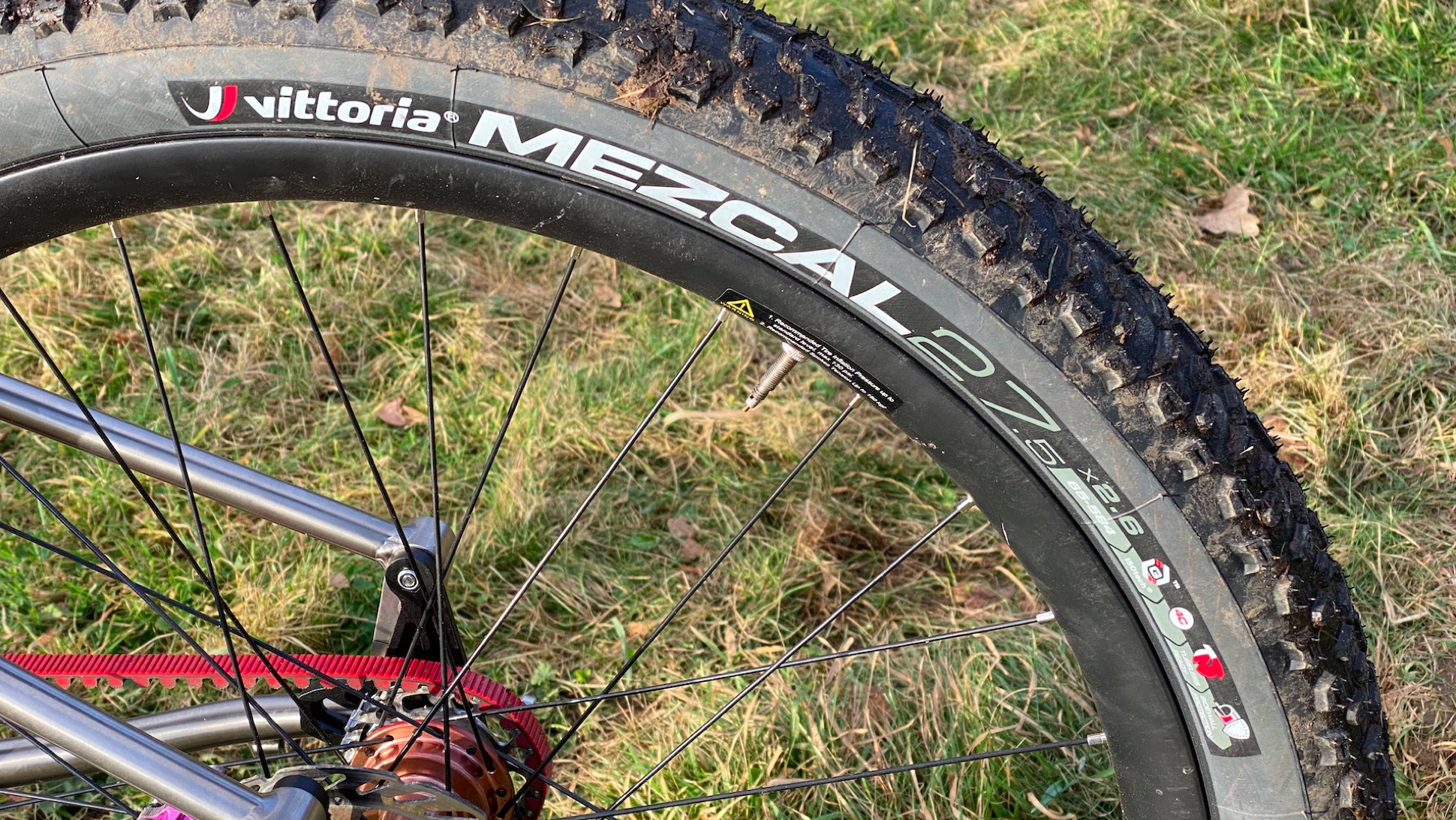
If you’re coming off a more modern bike that reach is definitely going to feel very short, though, and we can see many riders choosing the large frame for a bit more breathing room. It’s worth noting that the supplied rigid seatpost left us a couple of centimeters short of our usual pedaling position (74.5cm from bottom bracket to saddle top) at full extension too, so again you’ll need to size up and/or fit a longer stroke dropper post as intended by Steve. At this point you’ll be glad that the chainstays are relatively long so the slacker seat angle doesn’t cantilever you back and reduce front end stability further. Fans of a fat seat pack when bikepacking should definitely look at adding a bar bag to their rig to even things out, though.
Even with the sizing sorted out it’s still a bike that you’ll definitely sit “on top of” rather than “in”, and that cuts into confidence on faster or steeper sections where it can feel nervous and perched rather than planted. As the frame is tightly sprung rather than smoothly forgiving in feel, getting tire pressure right is crucial to achieving a consistent traction connection. Even a couple of PSI can make a big difference on the extra-wide rims, so be prepared to experiment extensively. Don’t chase pillowy comfort goals too far, though, as that’s not really in the bike’s character and you’ll find the Vittoria’s crumpling and flopping around before it’s smooth enough to emulate the limo in the Window Licker video the bars are named after.
The monster Maxxis front tire option does soften things up when you’re hovering around single-digit pressures and the lifted front also offsets the otherwise low bar height. It doesn’t help the climbing geometry, though, and the untamed pneumatic rebound can get out of hand on such a short and responsive bike if you start charging into lumpy stuff hard too.
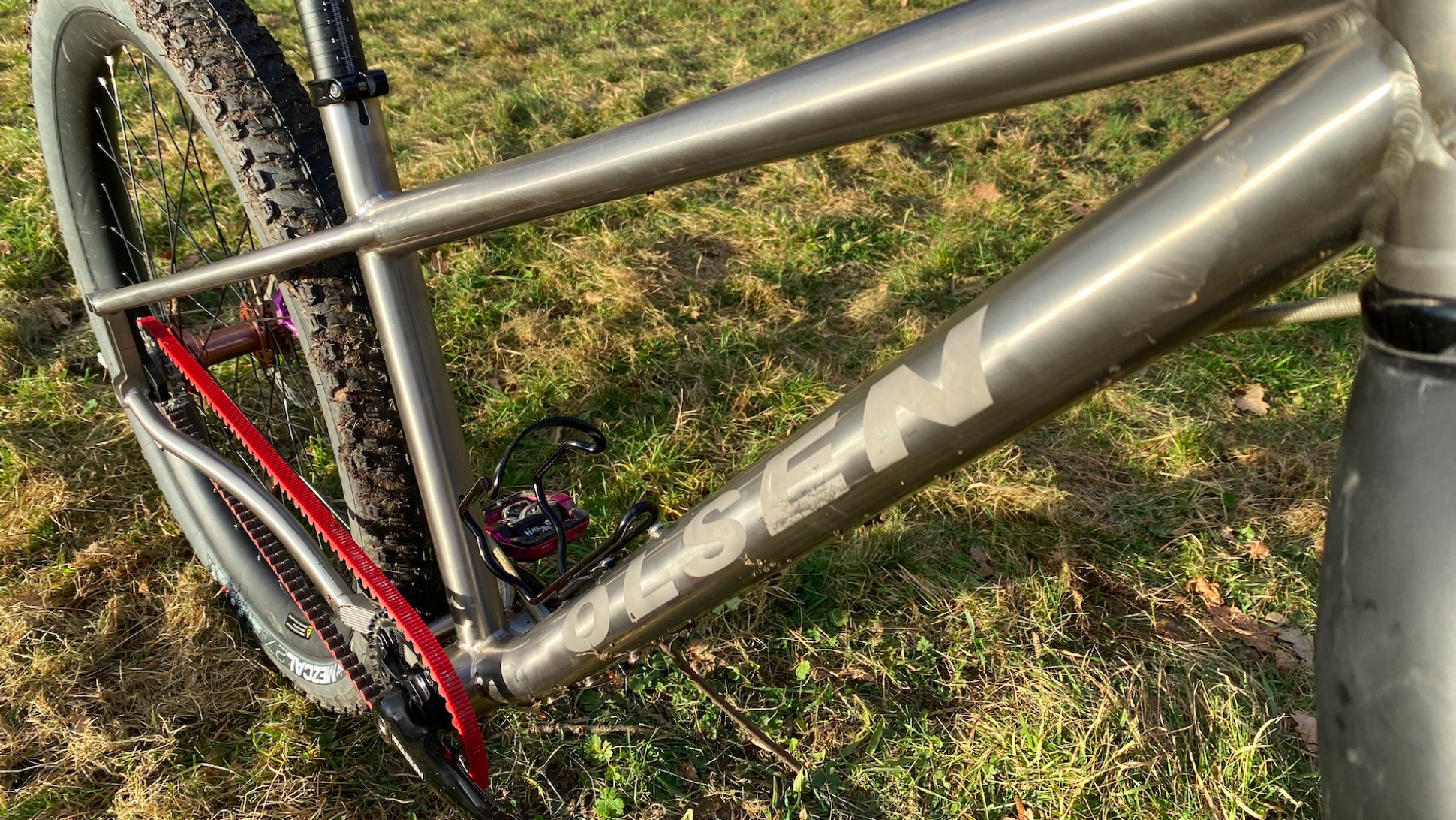
Verdict
This clearly isn’t designed as a bike for everyone and there’s a lot about this bike that you’ll either find delicious or disturbing. But if everything was the same that would be massively boring and if you’re after a taut, lively, very agile, close-combat singletrack bike, or spirited-feeling, compact position distance bike with “any drivetrain, big tire” compatibility then the Olsen is a very neatly designed and excellent value option.
For more details on the frame and complete builds, check out Olsenbikes.co.uk.
Test conditions
- Temperature range: 2-8 degrees
- Surface: Woodland trail, gravel, singletrack, bike path
Tech spec: Olsen Mokihinui
- Price: Frame – $1,657 / £999, Complete bike – $3,352.00 / £2100
- Discipline: Off-road adventure, touring
- Head angle: 67 degrees
- Frame material: 3AL 2.5V titanium
- Size: Small
- Weight: 10.5kg
- Wheel size: 27.5in x 2.6in
- Fork: MTN HELL full carbon tapered steerer fork
- Groupset: Carbon Drive belt transmission
- Crankset: Middleburn chainset
- Wheels: 50mm wide, deep carbon rims
- Tires: Vittoria Bardo and Mezcal 27.5 x 2.6 tires
- Brakes: Hope X2 brakes with 180/160mm rotors
- Bar/stem: Olsen Window Licker 780mm alloy bar, Olsen Aphex Twin CNC clamshell 40mm stem and Bike Ribbon grips
- Seatpost: Olsen Ribber alloy seat post
- Saddle: Selle Italia Model X Superflow saddle

Guy Kesteven has been working on Bike Perfect since its launch in 2019. He started writing and testing for bike mags in 1996. Since then he’s written several million words about several thousand test bikes and a ridiculous amount of riding gear. He’s also penned a handful of bike-related books and he reviews MTBs over on YouTube.
Current rides: Cervelo ZFS-5, Specialized Chisel, custom Nicolai enduro tandem, Landescape/Swallow custom gravel tandem
Height: 180cm
Weight: 69kg

